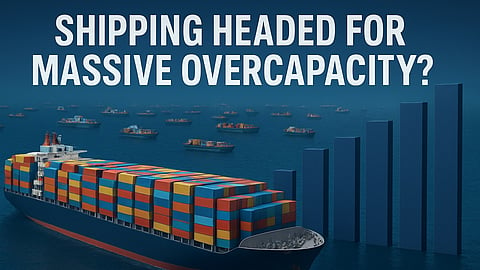A Decade of Overcapacity Sets Up Choppy Waters for Shipping into 2029
The container shipping industry is entering what analysts warn may become a prolonged period of oversupply one that could stretch well into the end of the decade.
Thanks to the surge in cargo volumes over the last few years and subsequent liner profits, carrier orders are surging. As of late 2024 and early 2025, shipowners placed a record volume of orders - 8.4 million TEU worth of new container vessels - the highest level since data collection began in 2000.
Globally, about 31.7% of the current fleet capacity is now on order. A similar scale of new-building boom triggered a ten-year overhang following the mid-2000s expansion.
Supply Outpacing Demand, By Far
Supply growth is outpacing demand. By 2026, liner capacity is forecast to rise 46% over 2019 levels, while cargo volumes are expected to climb only 22%.
Container Shipping Sees Robust Half-Yearly Growth in 2025
Shipping cycles have swung decisively in favor of shippers. Net fleet growth (on a TEU basis) nearly doubled demand growth in 2023 and 2024, and this imbalance will persist through 2026 - even as it slightly eases, only to ramp up again by 2027 and 2028.
Carriers deploying several tactics to manage oversupply:
Blank sailings, slow steaming, layups and scrapping of older tonnage are expected to trim capacity by a few percentage points. Yet scrapping remains modest. Bimco projects a fleet reduction of only 3–5% via demolitions and slow-speed operations.
Meanwhile, intra-Asian routes have absorbed new vessels, but globally, deployed capacity still lags fleet growth by several percent.
Liner Industry Structure Shifts
Alliances are evolving too. Traditional arrangements like the 2M alliance are ending by 2025, with carriers seeking greater operational flexibility to adapt to shifting trade patterns and capacity pressures.
Simultaneously, the rise of mega-ships is concentrating cargo on fewer vessels and ports, straining service reliability and favoring carriers over shippers in rate negotiations.
Looking Ahead to 2029: What Lies in Store
This accumulation of newbuild capacity, on top of slackening demand, points to a prolonged downturn:
Falling freight rates and compressed margins: With capacity ample, rates will remain under pressure unless demand shifts unexpectedly.
Shift in deployment strategies: Mid-sized vessels may become preferred over ultra-large tonnage, due to flexibility and route diversification. For example, carriers may increasingly favor ships in the 12,000–17,000 TEU range.
Market consolidation and fleet adjustments: Scrappage, slower speeds, and blank sailings will continue but likely won’t fully rebalance the supply-demand gap.
Potential regional divergence: Fast-growing intra-Asian trade routes might outperform slower global corridors, giving localized breathing room.
Environmental and regulatory layers added: New emissions rules and fuel regulations could accelerate scrapping of older vessels but also cost carriers more in new builds.
Flexible fleet deployment and alliance restructuring
In summary, the industry is staring down a challenging horizon where capacity growth outstrips demand by a wide margin, pushing down freight rates and squeezing margins.
Tools like slow steaming and blank sailings offer partial relief. But the sheer scale of newbuilds and slow demolition suggest that market rebalancing could stretch right through 2029.
Carriers will need agile strategies, from flexible fleet deployment to alliance restructuring, to weather this extended downturn.
Read More: How Chinese Ships are Benefiting From the Red Sea Blockade


